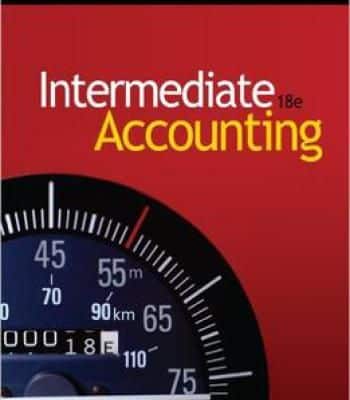Oftentimes when we hear about intermediate accounting, what comes to our mind is the next level after the accounting basics. Well, it is not so. So in this article, we are going to be looking at the actual definition of intermediate accounting. We will also see the importance of intermediate accounting, intermediate accounting topics, and intermediate accounting textbooks. We will also see a review of the best intermediate accounting textbook-like Kieso and Spiceland intermediate accounting.
Intermediate Accounting Definition
This is one of the courses of accounting in colleges or our regular universities. Thus, it is offered in the early years of accounting, offered in two semesters. Meanwhile, accounting is the study of internal business processes, record keeping, and transactions.
However, students who major in this field learn how to explain and develop financial statements. Therefore, they will be able to understand a variety of financial and managerial accounting ideas and routines. Also, this degree gives students the foundation needed to study for the Certified Public Accountant exam. In addition, it prepares them for careers as accountants in a variety of sectors. The sectors include; finance, education, real estate, and healthcare administration.
However, few students understand the field of accounting until they take this course in college. In fact, a publication by newaccountantusa.com notes the course’s status as a “weed-out class” for accounting majors. Hence, some students refer to the class as the most difficult they’ve ever taken.
Importance of Intermediate Accounting
This course contains subject matter which requires a higher level of thinking. Thus, it needs a greater ability to process earlier known knowledge than do most other courses the student will face. It’s also important for accounting majors as it serves as the base for much of their future accounting coursework. In addition, it is a course that helps students learn how to prepare income statements and cash flow statements. They also learn how to prepare balance sheets.
Intermediate Accounting Topics
However, Intermediate accounting includes a wide range of topics that address the career of accounting. So, some of the Intermediate accounting topics include; reporting financial performance and position; revenue recognition; cash and receivables.
#1. Accounting for Retail Inventory
Inventory cost-flow assumptions explain the cost of inventory expenses on the income statement. Hence, it is one of the biggest intermediate accounting topics. In addition, an interesting expansion on this topic is accounting for retail inventory.
The retail inventory method uses a cost ratio to change the ending inventory valued from retail to cost. So, this works by taking goods available for sale at cost and dividing them by goods available for sale at retail. You can then multiply sales by the resulting percentage to come up with ending inventory at cost.
#2. Accounting for property, plant, and equipment:
Intermediate accounting gets deep into accounting for spontaneous changes such as theft. As a result, a company has to record the difference between insurance income and the asset’s net book value. Then we note it as gain or loss on the sale of the asset.
#3.Research and development expenses (R&D):
We rarely discuss these tough intermediate accounting topics in financial accounting class. It shows you how to handle the costs of R&D. For instance when a drug company is developing a product to bring to market.
#4. Accounting for income taxes:
No one takes income taxes and your financial accounting textbook discussing these intermediate accounting topics lightly. Hence, Intermediate accounting to the rescue! Thus, it covers how to calculate the difference between financial and tax accounting.
Meanwhile, A major difference between the two is financial and tax depreciation. In addition, financial depreciation takes the long-way home while tax depreciation takes the shortcut through the vacant lot! So, net income between the two will differ.
#5. Time value of money:
This topic involves advanced time value issues, such as deferred annuities and long-term bonds. Annuities are multiple payments over a period of time that you either make or receive. Deferred annuities are a type of annuity contract that delays payments to the investor till the investor chooses to receive them. Also, Long-term bonds are bonds a business holds in another company that extends out. It holds for more than a year into the future.
Intermediate Accounting Textbooks
Here are some of the best Intermediate accounting textbooks that can help to break down the coursework. Generally, they are great resources for accounting majors, practicing accountants, or CPA/AICPA/GAAP studies.
Furthermore, these intermediate accounting textbooks will familiarize you with a lot of accounting factors. Factors include; reporting standards, solutions methodology, cash flows, taxation, auditing, and advanced financial accounting principles.
Some of the Best Intermediate Accounting Textbook include;
#1. Intermediate Accounting textbook by Donald Kieso and Jerry J. Weygandt,
#2. Cases in Financial Reporting by Drake,
#3. Intermediate Accounting by David Spiceland, Mark W. Nelson, and Wayne M. Thomas
#4. intermediate Accounting by Elizabeth A. Gordon,
#5. Accounting Made Simple – Accounting Explained in 100 Pages or Less by Mike Piper
#6. Accounting All-in-One For Dummies by Kenneth Boyd, Lita Epstein, Mark P. Holtzman, Frimette Kass-Shraibman, Maire Loughran, Vijay S. Sampath, John A. Tracy, Tage C. Tracy, Jill Gilbert Welytok.
#7. Warren Buffett Accounting Book: Reading Financial Statements for Value Investing Buffett Book Edition by Stig Brodersen and Preston Pysh.
#8. Narrative and Numbers: The Value of Stories in Business by Aswath Damodaran.
#9. The Tax and Legal Playbook: Game-Changing Solutions to Your Small-Business Questions. by Mark J. Kohler.
#10. Accounting Game: Basic Accounting Fresh from the Lemonade Stand by Darrell Mullis and Judith Orloff.
#11. Financial Shenanigans: How to Detect Accounting Gimmicks & Fraud in Financial Reports by Howard Schilit and Jeremy Perler
#12. Visual Finance: The One Page Visual Model to Understand Financial Statements and Make Better Business Decisions by Georgi Tsvetanov
#13. Cost Accounting: A Managerial Emphasis by Charles T. Horngren, Srikant M. Datar, and George Foster
#14. How to Read a Financial Report: Wringing Vital Signs Out of the Numbers | by John A. Tracy
#15. Accounting Principles | by Jerry J. Weygandt, Paul D. Kimmel, and Donald E. Kieso
#16. A Brief History of Economic Genius by Paul Strathern
Spiceland Intermediate Accounting

This provides a rigorous yet sharp approach to Intermediate Accounting, challenging students while ensuring they reach their best potential. Also, Spiceland uses a highly praised conversational writing style, wide coverage, and a clear, even tone.
The Spiceland/Nelson/Thomas author team has, however, created the new standard in this intermediate accounting course. Additionally, it provides students with the most open, wide, and current accounting learning system. So the rigorous yet simple approach has won over instructors across the country.
Meanwhile, the tenth edition continues to use Connect as a digital teaching and learning tool on the market. It engages the most recent FASB updates in both print and digital content. In addition, it includes Leases, Financial Instruments, Revenue Recognition, and more.
Also, Spiceland Intermediate Accounting excels in fully preparing students for the CPA exam and their future careers. The materials have a highly praised conversational writing style and a wealth of online tools. In addition, the authors help students develop a better understanding of both theoretical and practical concepts. Consequently, this gives them a mastery of accounting principles.
Furthermore, the tenth edition has produced a thoroughly market-tested, and fully-integrated coverage for the latest GAAP and Accounting Standards Updates. It also has tax reforms from the 2017 Tax Cuts and Jobs Act, including; Income taxes, Leases, Revenue recognition.
Features of Spiceland Intermediate Accounting Textbook
Some of the features of the Spiceland intermediate accounting tenth edition include;
#1. Auto-Graded decision makers’ perspective cases.
#2.General ledger problems.
#3. Concept overview videos.
#4. Excel simulations.
#5. Guided example hint videos.
#6. ALEKS accounting cycle review.
#7. Tableau data analytics cases.
Kieso Intermediate Accounting Textbook
Intermediate Accounting, 17th Edition textbook is written by industry thought leaders, Kieso, Weygandt, and Warfield. It revolves around one simple proposition: create great accountants.
Furthermore, Upholding industry standards, this edition includes new data analytics content. It has up-to-date coverage of leases, revenue recognition, financial instruments, and US GAAP & IFRS. However, it also maintains its credit for accuracy, understanding, and accessibility. So, Kieso Intermediate Accounting textbook drives results by helping students build professional competencies through reliable problem material.
99% of surveyed accountants feel that the Intermediate Accounting textbook by Kieso helped prepare them for success in the profession. In other words, professionals who learned accounting from these books find themselves well prepared to enter the workplace. So well prepared in fact, that many keep their copy of the text to refer to again and again.
Why is this text so vital for professional success? This 12th edition of this textbook shows the state-of-the-art in accounting today. In addition, the text is kept current with a Newsletter. Thus, this newsletter is a publication for users of the text that shows the very latest developments and their effects.

Features of Kieso Intermediate Accounting
#1. Data analytics that prepares students for the changing profession.
#2. Integrated CPA exam that reviews and prepares students for success.
#3. Video homework assistance that reaches all types of learners.
#4. Easy assessment.
#5. Extra practice.
#6. Organized learning platform.
#7. Practice made simple.
#8. Problem solution walkthrough videos
#9. Data analytics module.
#10. Wiley accounting updates.
#11. Video library.
In conclusion, we can see that this course builds on the basics of financial accounting and reporting. Thus, the students learn in an introductory financial accounting course. Also, students can learn about the preparation and interpretation of financial statements in accordance with generally accepted accounting policies, accounting for complex business transactions, and ways to evaluate firm performance.
Significant Distinctions Between US and International Accounting Standards
Your intermediate accounting textbook focuses on generally accepted accounting standards (GAAP) in the United States, but it also includes international viewpoints on accounting for the same events where applicable. Both perspectives are taken into consideration because GAAP and international accounting standards are on the cusp of convergence, and a single set of global accounting rules may emerge. The following are some important distinctions between US and international accounting standards:
#1. Extraordinary Items:
These are items that are extraordinary in nature and occur infrequently. Losses stemming from a major casualty, such as a fire, are an example. Special financial reporting is permitted under US GAAP for certain types of occurrences, although foreign standards do not.
#2. Lease Accounting:
Under US GAAP, whether a firm expenditures lease payments or treat them as loan payments, dividing the payment between principal and interest, is determined by GAAP capitalization standards. International rules are more user-friendly, and they consider the fundamental facts and conditions of the lease to determine whether lease payments are expensed or capitalized.
#3. Tax Deferrals:
Deferrals appear on the balance sheet as a result of the disparity between financial and tax revenue. Depending on the circumstances, US GAAP allows for deferrals to be classified as current or non-current. These deferrals can only be treated as non-current under international standards.
#4. Preparing the balance sheet:
It’s common knowledge in financial accounting that current accounts appear on the balance sheet before non-current ones. Current assets, such as cash, are listed before property, plant, and equipment. Non-current obligations, on the other hand, are frequently listed before current liabilities in companies that use international standards.
#5. Monetary assumptions:
For accounting measurement and analysis, US GAAP ignores the influence of inflation and deflation. Countries experiencing persistent inflation will use international accounting rules to generalize a price index to account for the influence of inflation on their financial reporting.
What is the role of cost accounting in intermediate accounting?
Cost accounting involves determining the cost of products or services provided by a company. In intermediate accounting, cost accounting principles and techniques are used to make informed decisions about pricing and product costing, as well as to measure and improve organizational efficiency.
What is the difference between financial accounting and managerial accounting?
Financial accounting focuses on the preparation of financial statements for external users, such as investors and creditors. Managerial accounting provides internal information for management decision-making and is not subject to the same reporting requirements as financial accounting.
What is the purpose of an interim financial report?
An interim financial report is a financial report that covers a shorter time period than a full financial report. It provides an update on a company’s financial performance and is usually issued to stakeholders on a regular basis, such as quarterly or semi-annually.
What are the different types of financial statements used in intermediate accounting?
The three main financial statements used in intermediate accounting are the balance sheet, income statement, and statement of cash flows. These statements provide a comprehensive view of a company’s financial position, performance, and liquidity.
How does intermediate accounting address revenue recognition and measurement?
Intermediate accounting addresses the recognition and measurement of revenue by establishing guidelines and principles for when revenue can be recognized and how it should be measured. This includes considering issues such as the timing of revenue recognition, the collectibility of revenue, and the allocation of revenue to specific periods.
How does intermediate accounting address the valuation of assets and liabilities?
Intermediate accounting provides guidance on the valuation of assets and liabilities by establishing accounting principles and guidelines for the measurement and reporting of these items. This includes considering issues such as the use of historical cost, the measurement of impairment losses, and the determination of the fair value of assets and liabilities.
Intermediate Accounting FAQ’s
What is an intermediate accounting?
Intermediate Accounting is a financial accounting course of study. The goal is to describe how accounting for these transactions is often done, or in certain circumstances, what options exist in current practice, and to adequately prepare accountants for treatment of the most common cases.
Is Intermediate Accounting hard?
Intermediate accounting is challenging because it involves a lot of detail. To be effective, you must have a solid understanding of accounting fundamentals. So, if you understand the foundations of accounting, it is not difficult to learn.
What do intermediate accountants do?
Accounts payable and receivable must be reconciled on a daily basis. Examine the prepared documents for accounting accuracy. Prepare financial statements and end-of-month journal entries for the month and year.
What is Intermediate accounting 2 all about?
This course focuses on the application of generally accepted accounting standards and financial pronouncements to financial reporting and disclosure of current and noncurrent liabilities and stockholders’ equity.






